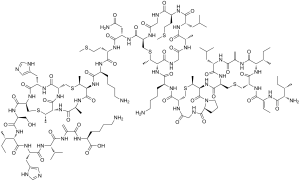Hi & Ni Amsterdam 2014, one month to go
Hi & Ni Amsterdam 2014, one month to go. Visit us at booth K26.
Hi & Ni Amsterdam 2014, one month to go. Visit us at booth K26.
Transglutaminase (TG) is an enzyme which is widely distributed in nature, and is composed of simple amino acid chains, and has been studied by many researchers for food use around the world. Siveele Transgluseen product is produced through fermentation process which is similar to making beer, wine and cheese, using conventional microorganisms.
TG preparation is able to improve the physical properties of various foods containing proteins. The use of the product offers various benefits to food companies and final consumers. In bakery and milk products, TG preparation improves texture. In process meat products, such as emulsified sausage and cooked ham, it improves texture and increases connectivity, thus decreasing loss during manufacturing process. In meat and fish, TG preparation enables combining quality parts of meat/fish, decreasing loss and waste, and consequently reducing pricing of the final products. This is an important contribution to a responsible and sustainable food chain. This also helps to reduce the negative environmental effects of farming by maximizing the use of the food that is produced. TG preparation also replaces binding agents such as salt, allowing consumers to benefit from a lower salt intake.
TG catalyzes the cross-link of side chains of two amino acids (glutamine and lysine) in liquefied proteins, and thus yielding ε- (γ-glutamyl)-lysine bond. This bond is stable against heat treatment or physical stress. Typically TG works within the protein of food materials, and contributes to improving texture properties. In case TG is used to combine quality meat/fish parts, TG works to the proteins which are added to the food applications. TG itself does not combine meat/fish parts. This is basically possible with TG and liquefied proteins. There is no technological function or effect of enzyme in the final product.
| Number | Food Category | ||
| 01.1 | Milk and dairy-based drinks | ||
| 01.1.1 | Milk and buttermilk (plain) | ||
| 01.1.1.1 | Milk (plain) | ||
| 01.1.1.2 | Buttermilk (plain) | ||
| 01.1.2 | Dairy-based drinks, flavoured and/or fermented (e.g., chocolate milk, cocoa, eggnog, drinking yoghurt, whey-based drinks) | ||
| 01.2 | Fermented and renneted milk products (plain), excluding food category 01.1.2 (dairy-based drinks) | ||
| 01.2.1 | Fermented milks (plain) | ||
| 01.2.1.1 | Fermented milks (plain), not heat-treated after fermentation | ||
| 01.2.1.2 | Fermented milks (plain), heat-treated after fermentation | ||
| 01.2.2 | Renneted milk (plain) | ||
| 01.3 | Condensed milk and analogues (plain) | ||
| 01.3.1 | Condensed milk (plain) | ||
| 01.3.2 | Beverage whiteners | ||
| 01.4 | Cream (plain) and the like | ||
| 01.4.1 | Pasteurized cream (plain) | ||
| 01.4.2 | Sterilized and UHT creams, whipping and whipped creams, and reduced fat creams (plain) | ||
| 01.4.3 | Clotted cream (plain) | ||
| 01.4.4 | Cream analogues | ||
| 01.5 | Milk powder and cream powder and powder analogues (plain) | ||
| 01.5.1 | Milk powder and cream powder (plain) | ||
| 01.5.2 | Milk and cream powder analogues | ||
| 01.6 | Cheese and analogues | ||
| 01.6.1 | Unripened cheese | ||
| 01.6.2 | Ripened cheese | ||
| 01.6.2.1 | Ripened cheese, includes rind | ||
| 01.6.2.2 | Rind of ripened cheese | ||
| 01.6.2.3 | Cheese powder (for reconstitution; e.g., for cheese sauces) | ||
| 01.6.3 | Whey cheese | ||
| 01.6.4 | Processed cheese | ||
| 01.6.4.1 | Plain processed cheese | ||
| 01.6.4.2 | Flavoured processed cheese, including containing fruit, vegetables, meat, etc. | ||
| 01.6.5 | Cheese analogues | ||
| 01.6.6 | Whey protein cheese | ||
| 01.7 | Dairy-based desserts (e.g., pudding, fruit or flavoured yoghurt) | ||
| 01.8 | Whey and whey products, excluding whey cheeses | ||
| 01.8.1 | Liquid whey and whey products, excluding whey cheeses | ||
| 01.8.2 | Dried whey and whey products, excluding whey cheeses |
(c) FAO and WHO 2009
Thank you all for visiting our booth. It was a great show. See you next year in Shanghai. #FIC2014
Visit us and our Chinese partner in FIC at booth 2C60! See you in Shanghai. #FIC2014
FIC (Food Ingredients China) 2014 is coming! Visit www.fi-c.com for more information. #FIC2014
Nisin, the active ingredient in Niseen®, is a polycyclic antibacterial peptide with 34 amino acid residues used to prevent spoilage and extend shelf life of various foods by inhibiting Gram-positive spoilage and pathogens. Nisin is effective against a wide range of Gram-positive bacteria, both as vegetative cells and as spores, used worldwide since 1953 to control bacterial spoilage in both heatprocessed and low-pH foods. It is a small peptide produced by Lactococcus lactis, a bacterium which occurs naturally in milk.
Nisin was found naturally in milk in 1950s, and commercialized at 2.5% concentration in 1953. In 1969, Nisin was approved for use as an antimicrobial in
food by the Joint FAO/WHO Expert Committee on Food Additives. After then Nisin has been given E number E234 in Europe as natural food additives and is permitted currently for use in over 50 countries.

CAS number: 1414-45-5
E number: E 234
Molecular formula: C143H230N42O37S7
Molar mass: 3354.07 g/mol
Boiling point: 2966 °C, 3239 K, 5371 °F
Density: 1.402 g/mL
Nisin works in a concentration dependent fashion; thus the more bacteria present in a food the more Nisin may be required. Nisin initially forms a complex with Lipid II, a precursor molecule in the formation of bacterial cell walls. The Nisin–lipid II complex then inserts itself into the cytoplasmic membrane forming pores and allows the efflux of essential cellular components resulting in inhibition or death of the bacteria.
Nisin is a natural antibacterial food preservative as it is a polypeptide produced by certain strains of the food-grade lactic acid bacterium Lactococcus lactis subsp. lactis during fermentation production. Research also shows it is also toxicologically safe. In 1969, Nisin was approved for use as an antimicrobial in food by the Joint FAO/WHO Expert Committee on Food Additives.
Minervum 7366 | 4817 ZH Breda
www.siveele.com | info@siveele.com
T: +31 (0)76 5710222
This site uses cookies. By continuing to browse the site, you are agreeing to our use of cookies.
OKLearn moreWe may request cookies to be set on your device. We use cookies to let us know when you visit our websites, how you interact with us, to enrich your user experience, and to customize your relationship with our website.
Click on the different category headings to find out more. You can also change some of your preferences. Note that blocking some types of cookies may impact your experience on our websites and the services we are able to offer.
These cookies are strictly necessary to provide you with services available through our website and to use some of its features.
Because these cookies are strictly necessary to deliver the website, you cannot refuse them without impacting how our site functions. You can block or delete them by changing your browser settings and force blocking all cookies on this website.
These cookies collect information that is used either in aggregate form to help us understand how our website is being used or how effective our marketing campaigns are, or to help us customize our website and application for you in order to enhance your experience.
If you do not want that we track your visist to our site you can disable tracking in your browser here:
We also use different external services like Google Webfonts, Google Maps and external Video providers. Since these providers may collect personal data like your IP address we allow you to block them here. Please be aware that this might heavily reduce the functionality and appearance of our site. Changes will take effect once you reload the page.
Google Webfont Settings:
Google Map Settings:
Vimeo and Youtube video embeds:
